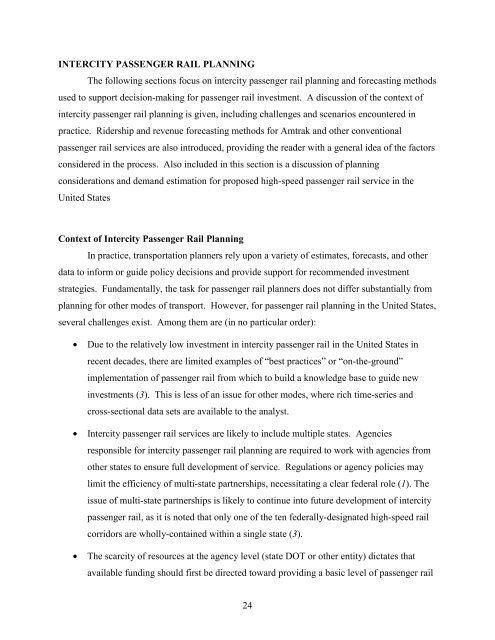Measuring the Benefits of Intercity Passenger Rail: A Study
Measuring the Benefits of Intercity Passenger Rail: A Study
Measuring the Benefits of Intercity Passenger Rail: A Study
Create successful ePaper yourself
Turn your PDF publications into a flip-book with our unique Google optimized e-Paper software.
INTERCITY PASSENGER RAIL PLANNING<br />
The following sections focus on intercity passenger rail planning and forecasting methods<br />
used to support decision-making for passenger rail investment. A discussion <strong>of</strong> <strong>the</strong> context <strong>of</strong><br />
intercity passenger rail planning is given, including challenges and scenarios encountered in<br />
practice. Ridership and revenue forecasting methods for Amtrak and o<strong>the</strong>r conventional<br />
passenger rail services are also introduced, providing <strong>the</strong> reader with a general idea <strong>of</strong> <strong>the</strong> factors<br />
considered in <strong>the</strong> process. Also included in this section is a discussion <strong>of</strong> planning<br />
considerations and demand estimation for proposed high-speed passenger rail service in <strong>the</strong><br />
United States<br />
Context <strong>of</strong> <strong>Intercity</strong> <strong>Passenger</strong> <strong>Rail</strong> Planning<br />
In practice, transportation planners rely upon a variety <strong>of</strong> estimates, forecasts, and o<strong>the</strong>r<br />
data to inform or guide policy decisions and provide support for recommended investment<br />
strategies. Fundamentally, <strong>the</strong> task for passenger rail planners does not differ substantially from<br />
planning for o<strong>the</strong>r modes <strong>of</strong> transport. However, for passenger rail planning in <strong>the</strong> United States,<br />
several challenges exist. Among <strong>the</strong>m are (in no particular order):<br />
• Due to <strong>the</strong> relatively low investment in intercity passenger rail in <strong>the</strong> United States in<br />
recent decades, <strong>the</strong>re are limited examples <strong>of</strong> “best practices” or “on-<strong>the</strong>-ground”<br />
implementation <strong>of</strong> passenger rail from which to build a knowledge base to guide new<br />
investments (3). This is less <strong>of</strong> an issue for o<strong>the</strong>r modes, where rich time-series and<br />
cross-sectional data sets are available to <strong>the</strong> analyst.<br />
• <strong>Intercity</strong> passenger rail services are likely to include multiple states. Agencies<br />
responsible for intercity passenger rail planning are required to work with agencies from<br />
o<strong>the</strong>r states to ensure full development <strong>of</strong> service. Regulations or agency policies may<br />
limit <strong>the</strong> efficiency <strong>of</strong> multi-state partnerships, necessitating a clear federal role (1). The<br />
issue <strong>of</strong> multi-state partnerships is likely to continue into future development <strong>of</strong> intercity<br />
passenger rail, as it is noted that only one <strong>of</strong> <strong>the</strong> ten federally-designated high-speed rail<br />
corridors are wholly-contained within a single state (3).<br />
• The scarcity <strong>of</strong> resources at <strong>the</strong> agency level (state DOT or o<strong>the</strong>r entity) dictates that<br />
available funding should first be directed toward providing a basic level <strong>of</strong> passenger rail<br />
24
















